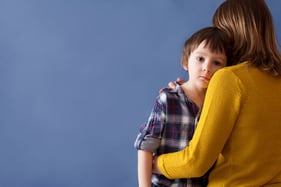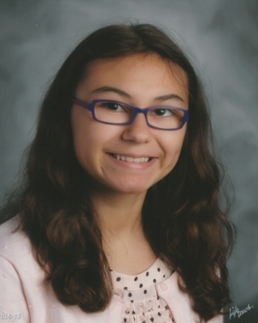You’ve been to the optometrist or an ophthalmologist, and you’ve just been told your child has amblyopia (lazy eye). And, if your child is over the age of eight, you may have even been told there is no way to treat the condition.

This news obviously comes as a shock. Even though amblyopia affects 2-4% of children in this country, you’ve probably never heard of the condition. Like any concerned parent, you’ve scrambled to your computer, your mind racing with questions.
So what exactly is amblyopia? What is a lazy eye? Are they different? Let’s take a look.

Amblyopia is the medical term for “lazy eye.” We define amblyopia (lazy eye) as the lack of development of clear vision in one or both eyes. It occurs for reasons other than an eye health problem that cannot be improved with glasses alone.
The term “lazy eye” is typically used when one eye is affected and is derived from the fact that one eye sees more clearly than the other. This clearer-seeing eye is thought to perform the bulk of seeing, which makes us consider the other eye “lazy.”
In cases where the image of one eye is affected, the brain cannot effectively combine the two images and it suppresses, or “turns off” one of them. The constant suppression of an image from one eye can lead to the development of amblyopia in that eye.
In cases where the images of both eyes are affected, the brain never develops the ability to see clearly with both of the eyes.
There can be several reasons why the vision is affected:
The visual system is designed to use both eyes to explore visual space. When both eyes see similarly and the brain can easily combine the images, it is called binocular (literally “two eyed”) vision. An amblyope has binocular vision, they are just not very good at it. They are binocular peripherally and suppress centrally.
Amblyopia most commonly affects one eye, but may occur in both eyes as well.
Large differences in vision/prescriptions between the two eyes
Constant eye turn in one eye
Reduced vision in one eye due to physical problems in the eye (e.g. corneal opacity, cataract)
Amblyopia, or “lazy eye,” is often confused with strabismus, or “crossed eyes.” Strabismus is when an eye is physically turned in, out, up or down. Strabismus is related to eye alignment, while amblyopia has to do with the sharpness of the images in each eye.
A constant unilateral strabismus can actually cause amblyopia (one eye is turned all the time), while alternating or intermittent strabismus rarely causes “lazy eye.”
Strabismus is usually easy to spot, but amblyopia is not. Without actually checking the acuity in each eye and the refractive condition of both eyes, it can be very difficult to tell whether a child has amblyopia.
Amblyopia is difficult to detect by simple observation. The most common indicator is an obvious difficulty with depth perception. A person who has trouble catching and throwing objects, or is clumsy and always bumping into things, may have amblyopia.
Amblyopia can be detected at a school screening, but not always. One of the reasons it’s important for children to be seen for an eye exam from the first year of life and on is because outwardly amblyopia is not obvious. Some kids will go for years before their parents notice there is a problem.
Children figure out how to function even with amblyopia. In some cases, the brain suppresses the image from the eye, so there isn’t any double vision. The child never realizes the brain is doing this because the eye is being suppressed.
If you’ve been told that your child has amblyopia, or “lazy eye,” then you may have also been told there’s no effective treatment for lazy eye in children older than the age of eight. That’s simply not true. Adults with amblyopia can be treated.
The notion that older children and adults can’t be treated is based on a long-held, but incorrect, belief concerning the “critical period,” which was thought to end at age seven.
Since it is rare for amblyopia to develop in a child over the age of eight, many doctors over the years have assumed that the brain’s ability to change with respect to visual acuity is limited beyond this age.
However, recent research, as well as years of proven success among vision therapy patients, has proven that assumption wrong.
In her book Fixing My Gaze, neuroscientist Dr. Susan Barry relates how the misconception in the scientific and medical communities began.

Dr. Susan Barry
She writes that since the mid-1990s, the “scientific and medical communities have cited strabismus and a related disorder called amblyopia as classic examples of developmental disorders that cause permanent changes in vision if they are not corrected within a critical period in early life.”
The conclusions, she states, were based on experiments by David Hubel and Torsten Wiesel at Harvard Medical School. The two studied cats had strabismus, or misaligned eyes. It was noted that the vision in the cats had not developed normally, and that they could not see in 3D.
Many scientists and doctors assumed the cats would never acquire stereo vision (where two eyes work together to produce a 3D image) because they had not acquired the ability during what is referred to as a “critical period” of vision development.
In this period, it was assumed, if certain visual skills (specifically visual acuity and stereopsis) were not learned by the brain, they could not be developed later in life.
Barry cites that more recent scientific research (see below) indicates otherwise. The adult brain appears to be more “plastic” than had been previously thought, and the circuitry of the brain can actually change at any age as a result of our actions and experiences.
Through a Functional Vision Test, we can test all aspects of the visual system to determine if amblyopia is present.

It‘s great to see clinical research backing what clinicians in the optometric vision therapy field have known for years. So what are these “traditional treatments” for amblyopia that are mentioned in the study?
Traditional treatment typically involves prescribing glasses and then patching the stronger eye with an eye patch or using eye drops to blur the better-seeing eye while doing daily activities. This is the common approach taken by many medical practitioners for amblyopia and the duration of the patching can vary from two to six hours per day depending on the severity of the amblyopia.
Traditionally, patching and/or prescribing glasses have been used to treat amblyopia, often for children at a younger age. Today, studies (see below) have shown that combining vision therapy with patching is a more effective treatment for lazy eye in children and adults than just patching alone.
The reason vision therapy is so important in amblyopia treatment is that it gets at the root cause: the two eyes do not perceive visual space the same and therefore cannot work together. They can’t produce healthy “binocular” vision.
Making the “lazy eye” see more clearly by patching alone does not automatically mean that the other visual information will be processed the same with each eye. It also does not do anything to help the brain learn to combine the information from the two eyes effectively. As a result, often the clarity of vision with the “lazy eye” may regress after patching has stopped.
People with amblyopia do not develop binocular vision, so it is a binocular problem, not a monocular problem. Patching is a monocular solution when a binocular solution is needed to prevent regression.
How do you correct lazy eye? Our goal for lazy eye is to train the brain to process information from each eye as equally as possible, and then train to get both eyes to work together as a team.

Basically, the two eyes don’t see visual space the same. We’re working to get the eyes to see visual space more similarly, so they can work as a team. The approach taken by developmental optometrists that practice vision therapy generally includes the following steps:
1. Find the right lenses or glasses
It’s important that we make sure the child has the right prescription. In addition to helping people see more clearly, lenses also change where things appear to be in space. We want to prescribe glasses that help the child see more clearly, but even more importantly to encourage binocular vision.
2. Use patching effectively
Studies indicate that the most effective treatment combines the use of patching with vision therapy. We may decide to start with patching and later add therapy or begin the patching and therapy simultaneously.
3. Retrain the visual system using vision therapy activities
How does vision therapy work? Using optical devices, patients engage in activities that help the visual system correctly process the visual information that the brain receives from the eyes. A person will practice these activities at home for generally 1 hour a day. These activities at home are combined with weekly office visits, and a typical program lasts 6-9 months. After that, the functional vision problem should be corrected.
The following links, compiled by Dan Fortenbacher of WOW vision, provide additional scholarly research on Amblyopia treatment.
Duration of treatment varies based on the severity of the amblyopia and adherence to the treatment. The best way to have an estimate of how long it will take to treat a specific case is to get a Functional Vision Test.
Amblyopia can be very difficult to detect. A Functional Vision Test is the first step for diagnosing the condition. Contact The Vision Therapy Center if you’re interested in scheduling a Functional Vision Test.
Surgery is sometimes performed for strabismus, but not for amblyopia. You don’t need surgery to fix lazy eye - you need vision therapy.
We’re often asked if there are lazy eye exercises. As part of your vision therapy treatment, doctors will prescribe a series of specific activities and exercises designed to retrain the eyes to work together.
Because amblyopia is difficult to detect, even in adults, it’s not easy to visually determine if an infant has lazy eye. But a developmental optometrist can conduct a series of tests to determine if a child has amblyopia.
Sometimes. A family history of strabismus and/or amblyopia is a risk factor for developing amblyopia.
Schedule a Function Vision Exam by filling out the form below.
The content on this website has been created by The Vision Therapy Center. It was written by professional writers and then reviewed and edited for medical accuracy by the Developmental Optometrists at The Vision Therapy Center.
The Vision Therapy Center, Inc. – Phone: 262-784-9201 FAX 262-784-9206
Locations
The Vision Therapy Center, Inc. - Brookfield, WI
13255 W Bluemound Rd #200
Brookfield, WI 53005
262-784-9201
Brookfield hours of operation / 8 am - 6 pm M-Th - 8 am - 5 pm F
The Vision Therapy Center, Inc. - Madison, WI
4781 Hayes Rd #103
Madison, WI 53704
262-784-9201
Madison hours of operation / 9:15 am - 5:45 pm Th
The Vision Therapy Center FDL, LLC - Fond du Lac, WI
101 Wisconsin American Drive, Suite 800
Fond du Lac, WI 54937
262-784-9201
Fond du Lac hours of operation / 9:00 am - 6:00 pm Tues